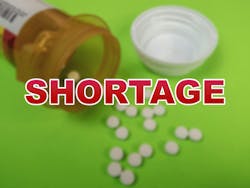On Nov. 13, the American Medical Association (AMA) adopted policy during the Interim Meeting of its House of Delegates furthering its work to address the worsening public health issue of drug shortages. Drug shortages have reached the highest they have been in a decade, according to a press release on the policy.
A press release states that “The AMA’s new policy supports efforts to encourage federal review and oversight of the practice by compounding pharmacies to advertise drugs that are actively in shortage, combat artificial drug shortages, and offer incentives to manufacturers seeking to invest in manufacturing processes.”
Further, “The advertising practices of on-patent drugs such as semaglutide, and other glucagon-like peptide-1 (GLP-1) agonists, have led to highly-publicized shortages over the last year. Semaglutide’s increase in popularity can largely be attributed to a massive advertising presence, particularly through social media, despite the drug being in constant shortage. Prolonged shortages combined with ultra-high demand have led to significant concerns over counterfeit products being sold to pharmacies struggling to keep up with new and existing patient needs, and compounding pharmacies finding loopholes to develop compounded versions of semaglutide that contain different active ingredients and have not been evaluated for safety and efficacy by the U.S. Food and Drug Administration (FDA). To help alleviate these shortages and ensure the drugs being sold are safe and effective, the AMA’s policy calls on the FDA, Federal Trade Commission, or other relevant oversight entities, to examine the practice by which compounding pharmacies use to advertise drugs that are actively in shortage, particularly when targeted to new patients.”
The press release adds that according to the American Society of Health-System Pharmacists statistics, drug shortages have worsened over the last year with new drug shortages continuing to rise and existing drug shortages taking longer to resolve. “For the first quarter of 2024, there have been 48 new drugs in shortage,” the release noted. “So far this year, the five classes of drugs facing the largest number of shortages include, central nervous system therapies, antimicrobials, hormones, chemotherapies, and fluids/electrolytes—placing significant burden on physicians and patients across all health care settings, including urban, rural, outpatient and inpatient.”
To assist in addressing the shortages, the policy was informed by a Council on Science and Public Health report that examined three categories of drugs in shortage, including controlled substances, generic drugs, and on-patent drugs, as well as proposed government actions to address them. Indeed, manufacturing quotas from the Drug Enforcement Administration (DEA) have led to drug shortages for certain controlled substances including mixed amphetamine salts that are used for the treatment of attention-deficit hyperactivity disorders. The new policy contests laws, regulations, or business practices which create artificial drug shortages that limit patients’ access to medications.
“The new policy also aims to bolster drug manufacturing through the use of incentives such as prioritized regulatory review, reduction of user fees, and direct grant opportunities for manufacturers seeking to invest in manufacturing processes,” the release commented. “To support the development of strategies and technologies to strengthen supply chain networks, the new policy calls for economic incentives for building climate and disaster resiliency and redundancy into new or updated facilities, increasing emergency stockpiles of key products, and incentivizing the innovation and adoption of reusable medical products to resist the impact of supply chain disturbances.”
The policy adopted, according to the release, builds upon AMA’s efforts to address growing drug shortages and ongoing supply challenges for vital medications.

